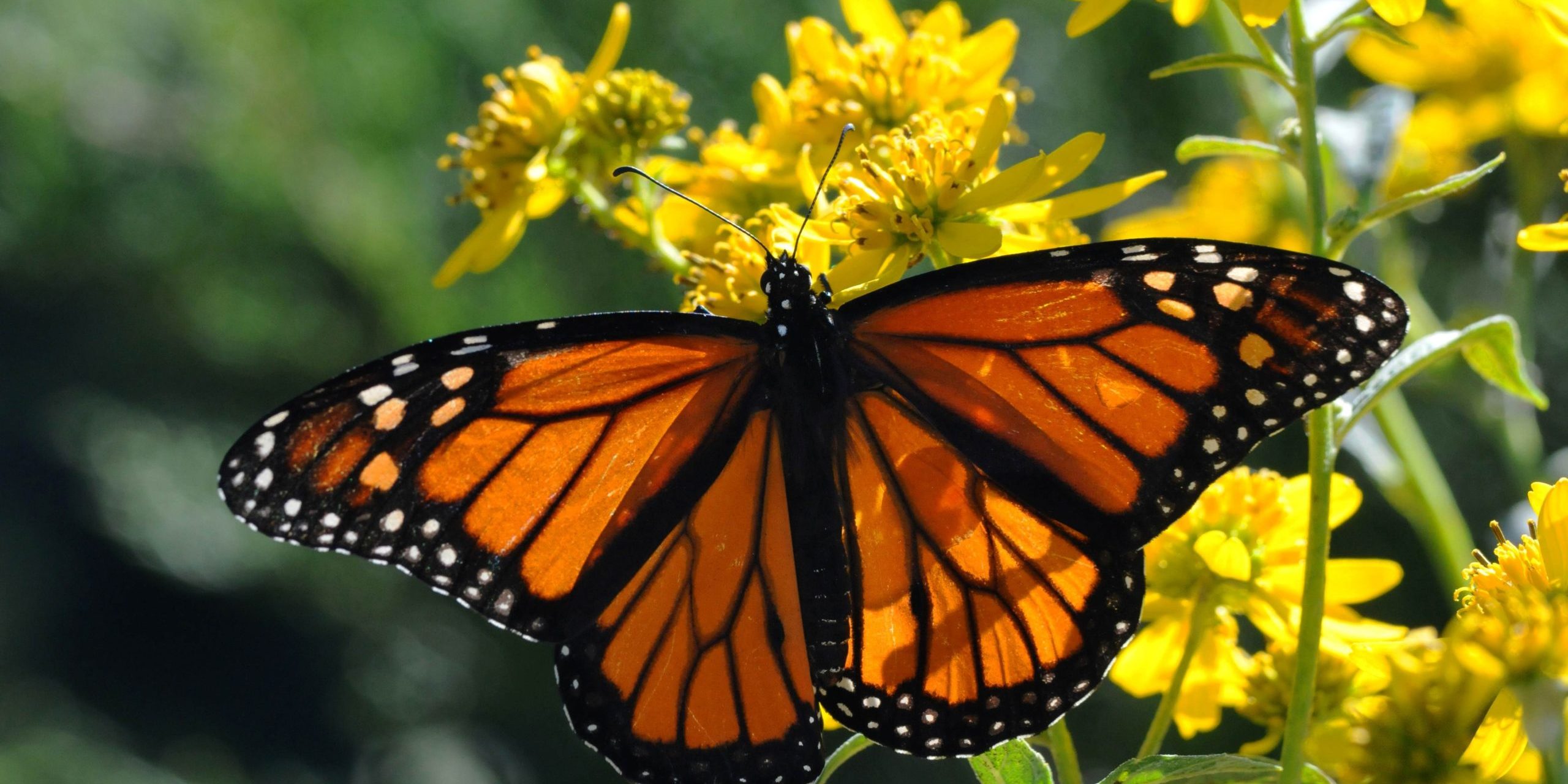Monarch Butterfly
The Monarch butterfly is a large brightly colored North American native that is distributed over six continents around the globe along with the milkweed plants on which it feeds. Two populations of Monarchs perform long-distance migrations from the northern United States to overwintering grounds in Baja California and Mexico. Standardized surveys of the overwintering populations in Mexico have shown a steady decline since monitoring began in 1994 (Vidal and Rendon-Salinas 2014). The primary threats identified for North American Monarch populations are declining overwintering habitats, loss of milkweed in the migratory corridor and insecticides use in agricultural areas (USFWS SSA 2021).
Common Name:
Monarch butterfly
Scientific Name:
Danaus plexippus
USFWS Endangered Species Act Status:
Candidate Species
TPWD Species Conservation Status
None Listed
Physical Description
The adult Monarch butterfly has large, bright orange wings, bordered by black veins with two rows of white spots on the black borders at the top and bottom of the forewings and hindwings. (Malcolm and Zalucki 1993). The bright coloring warns potential predators that they are toxic due to cardenolides that in milkweed.
Life History:
Monarchs lay eggs on milkweed plants (Asclepias spp.) during their spring and summer breeding season. The eggs hatch over a period of two to five days (Zalucki 1982). The black, white and yellow striped larvae feed on milkweed plants and form a chrysalis after nine to 18 days (Parsons 1965). The adult Monarch emerges from the chrysalis after six to 14 days, begins breeding, and perishes within two to five weeks. In North America, some populations live for six-to-nine months as they delay reproduction in the fall to migrate to overwintering grounds up to 30,000 miles away. (Cockerall 1993). In early spring the overwintering adults’ mate and begin the multi-generational migration back to spring and summer breeding grounds (Malcolm 1993).
Distribution:
Monarchs are found in 90 countries on six continents, with 31 documented populations worldwide. North America is home to two migratory populations east and west of the Rocky Mountains and one non-migratory population in Florida. The eastern migratory population has the most individuals in the world. The Monarch was likely introduced into other continents from North America in the late 1800s (Vane-Wright 1993).
Habitat and Diet:
Monarch caterpillars feed on milkweed (Malcolm and Bower 1996). Milkweed along migratory routes in spring and summer breeding grounds are frequently found in riparian corridors around water bodies, as well as rangelands, agricultural areas, roads and gardens (Pelton 2018). The overwintering habitat in Mexico is covered by dense clusters of fir trees at high elevations, which provide cool temperatures and protection from freezes (Williams and Bower 2015).
References:
Cockrell, B.J., Malcolm, S.B., and Brower, L.P. (1993). Time, temperature, and latitudinal constraints on the annual recolonization of eastern North America by the Monarch butterfly. in Biology and Conservation of the Monarch Butterfly. Natural History Museum of Los Angeles County, Science Series 38.
Cardno, Inc. (2020). Nationwide Candidate Conservation Agreement for Monarch Butterfly on Energy Transportation Lands. Energy Resources Center at the University of Illinois at Chicago. Fitchburg, Wisconsin.
Malcolm, S.B., and Zalucki, M.P. (1993). The monarch butterfly: Research and conservation. Biology and Conservation of the Monarch Butterfly. Natural History Museum of Los Angeles County, Science Series 38.
Parsons, J.A. 1965. A digitalis-like toxin in monarch butterfly Danaus plexippus L. Journal of Physiology-London 178, 290-304.
United States Fish and Wildlife Service. (2020). Monarch (Danaus plexippus) Species Status Assessment Report, Version 2.1.
Vane-Wright, R.I., (1993). The Columbus hypothesis: An explanation for the dramatic 19th century range expansion of the monarch butterfly. Biology and Conservation of the Monarch Butterfly. Natural History Museum of Los Angeles County, Science Series 38.
Vidal, O., López-García, J., and Rendón-Salinas, E. (2014). Trends in deforestation and forest degradation after a decade of monitoring in the Monarch Butterfly Biosphere Reserve in Mexico. Conservation Biology 28, 177-186.
Williams, E.H., and Brower, L.P. (2015). Microclimatic protection of monarch butterflies provided by Mexico’s high elevation Oyamel fir forests: A review. Monarchs in a Changing World: Biology and Conservation of an Iconic Insect. Cornell University Press. Ithaca, New York.
Zalucki, M.P. 1982. Temperature and rate of development in Danaus-plexippus L and D. chrysippus L (Lepidoptera, Nymphalidae). Journal of the Australian Entomological Society 21, 241-246.

